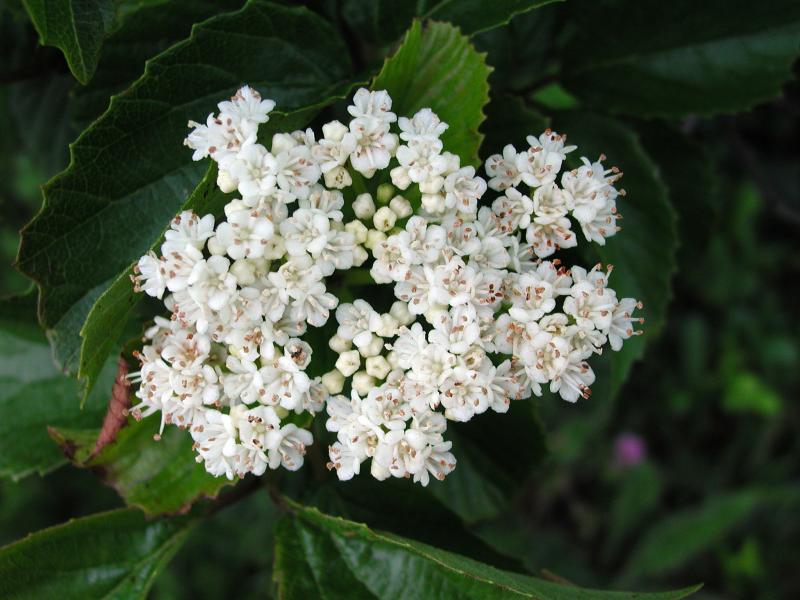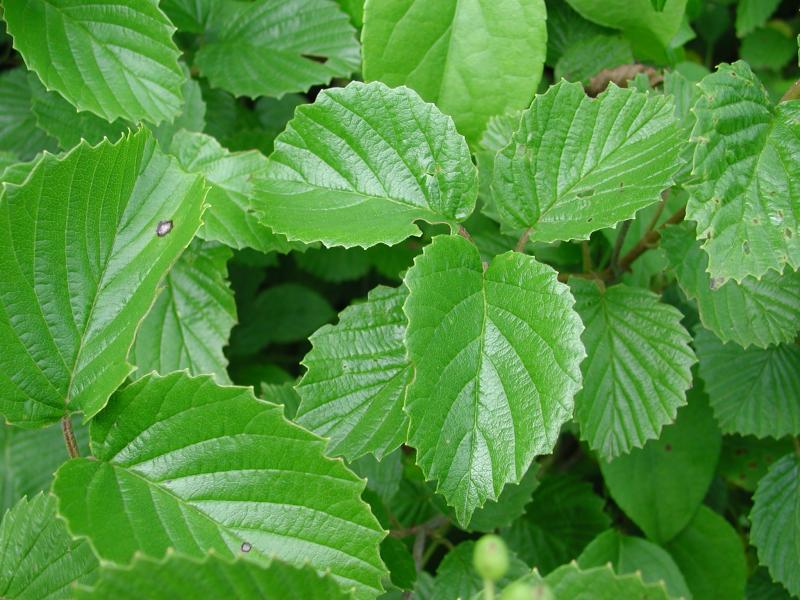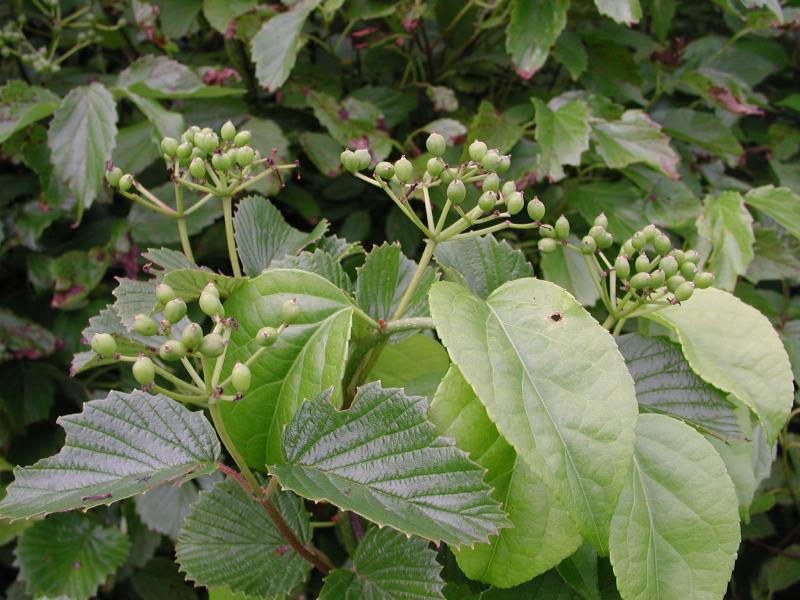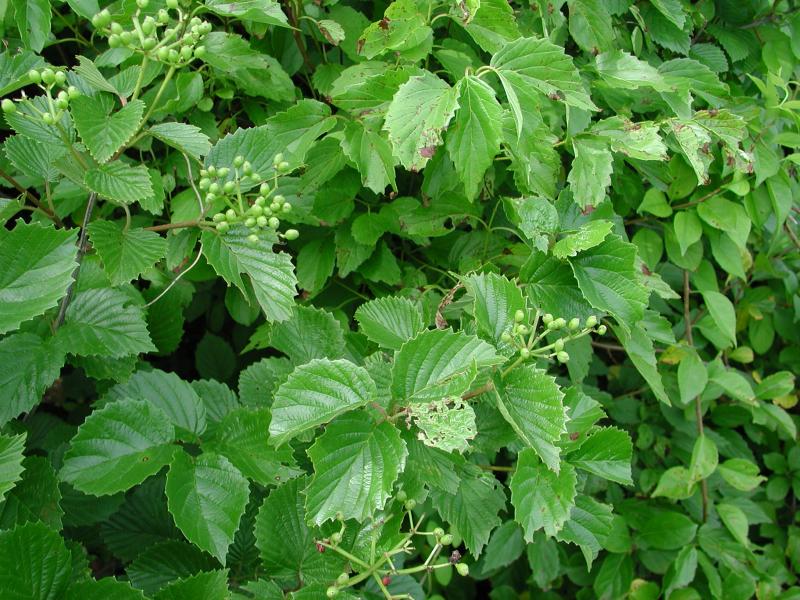Southern Arrowwood
Viburnum dentatum var. venosum (Britt.) Gleason
- Class
- Dicotyledoneae (Dicots)
- Family
- Viburnaceae
- State Protection
- Threatened
Listed as Threatened by New York State: likely to become Endangered in the foreseeable future. For animals, taking, importation, transportation, or possession is prohibited, except under license or permit. For plants, removal or damage without the consent of the landowner is prohibited.
- Federal Protection
- Not Listed
- State Conservation Status Rank
- S2
Imperiled in New York - Very vulnerable to disappearing from New York due to rarity or other factors; typically 6 to 20 populations or locations in New York, very few individuals, very restricted range, few remaining acres (or miles of stream), and/or steep declines.
- Global Conservation Status Rank
- G5T4T5
Apparently or Demonstrably Secure globally - The subspecies/variety is uncommon to common in the world, but not rare; usually widespread, but may be rare in some parts of its range; possibly some cause for long-term concern due to declines or other factors. More information is needed to assign either T4 or T5. (The species as a whole is common globally.)
Summary
Did you know?
The true abundance of this shrub is difficult to assess, because it is often hard to access every part of a maritime shrubland and not get covered in ticks! That is why most occurrences are known from road or trailsides where they are easily seen.
State Ranking Justification
There are 13 existing populations but only 3 of them are large and extensive. Most of them are small with fewer than 10 plants. There are 5 additional historical locations and no additional plants have been found.
Short-term Trends
Current populations seems stable, although some smaller groups of shrubs along the edges of highways may be affected by road maintenance or development.
Long-term Trends
This shrub has always been rare in New York and most of the known populations have been rediscovered. Current trends should continue into the foreseeable future.
Conservation and Management
Threats
Some plants that occur along roadsides are threatened by road maintenance that can damage them. Other plants are threatened by clearing of shrublands for developments and trails.
Conservation Strategies and Management Practices
Some disturbance of the forest is needed to provide areas that can succeed to shrubland where this species thrives. Existing shrubs need to be protected from direct disturbance by heavy machinery.
Research Needs
More precise information is needed about flowering and fruiting times compared to variety dentatum with which it occurs. Habitat preference information is also needed for the two varieties, especially where they occur in close proximity.
Habitat
Habitat
In New York Southern Arrowwood has been found in a variety of dry, sandy habitats near the coast, mostly dunes,shrublands, and old fields (New York Natural Heritage Program 2010). Moist or dry sandy thickets and borders of woods (Fernald 1970). Sandy soil of the coastal plain (Gleason & Cronquist 1991).
Associated Ecological Communities
- Coastal oak-hickory forest
(guide)
A hardwood forest with oaks and hickories codominant that occurs in dry, well-drained, loamy sand of knolls, upper slopes, or south-facing slopes of glacial moraines of the Atlantic Coastal Plain.
- Maritime dunes
(guide)
A community dominated by grasses and low shrubs that occurs on active and stabilized dunes along the Atlantic coast. The composition and structure of the vegetation is variable depending on stability of the dunes, amounts of sand deposition and erosion, and distance from the ocean.
- Maritime grassland
(guide)
A grassland community that occurs on rolling outwash plains of the glaciated portion of the Atlantic coastal plain, near the ocean and within the influence of offshore winds and salt spray.
- Maritime shrubland
(guide)
A shrubland community that occurs on dry seaside bluffs and headlands that are exposed to offshore winds and salt spray.
- Successional maritime forest*
(guide)
A successional hardwood forest that occurs in low areas near the seacoast. This forest is a variable type that develops after vegetation has burned or land cleared (such as pastureland or farm fields). The trees may be somewhat stunted and flat-topped because the canopies are pruned by salt spray. The forest may be dominated by a single species, or there may be two or three codominants.
* probable association but not confirmed.
Associated Species
- Amelanchier canadensis
- Myrica pensylvanica
- Photinia
- Prunus maritima (beach plum)
- Prunus serotina
- Quercus
- Rosa rugosa (Japanese rose)
- Rubus
- Sambucus
- Smilax
- Vaccinium corymbosum (highbush blueberry)
- Viburnum dentatum var. lucidum (smooth arrowwood)
Range
New York State Distribution
The shrub is most common on Eastern Long Island with scattered historical populations from the Bronx to Orange County to Columbia County where it has been extirpated.
Global Distribution
It occurs on the coastal plain of Massachusetts and New York south to Maryland and west to Pennsylvania and Ohio. It is also disjunct in Georgia.
Identification Comments
General Description
Southern Arrowwood is an opposite-branched, erect shrub growing up to 2 m tall. The leaves are opposite and simple with large teeth, mostly round, and the petioles and lower leaf surface are thickly covered with stellate (star-shaped) hairs. The lateral veins of the leaves fork at most 1-2 times, each fork extending to a tooh on the leaf margin, and the veins are raised on the lower surface. The flowers are white and borne laterally on 5-7 branched clusters. The fruit are blue-black when mature (Gleason and Cronquist 1991).
Best Life Stage for Proper Identification
Distinguishing characteristics: young branchlets often densely pubescent; leaves thick, mostly rotund, the lower surface thickly stellate and with strongly raised veins; petioles stellate; no stipules, no stipitate- glandular hairs; hypanthium glabrous or glandular; stone ellipsoid-ovoid; habitat generally is sandy soil. Best life stage for ID: in leaf and fruit. Southern Arrowwood may be identified from the leaves, though leaves and fruiting material together are best.
Similar Species
Viburnum dentatum as a species may be separated from other Viburnum species found in New York by having a regular infloresence (marginal flowers like the central ones) that is umbelliform at the base (unlike V. sieboldii that is oppositely branched); unlobed, dentate leaves with the simple (or only 1-2 forked) lateral veins each extending to a tooth, cordate leaf bases, and petioles about 1/3 as long as the leaf blades. The petioles are densely covered with sellate hairs. The veins below are hairy. The lookalike Viburnum dentatum var. lucidum is more typical across New York and is most often found in moist habitats such as woods, shrublands, successional old fields, or swamps but can co-occur with variety venosum. Viburnum dentatum var. lucidum has mostly ovate leaves with glabrous petioles (sometimes simple hairs in the groove) and lower leaf surfaces glabrous (sometimes pubescent only in the axils of the veins). Variety lucidum usually blooms and fruits slightly earlier than variety venosum.
Best Time to See
Southern Arrowwood flowers from late May to early July, and the fruits may persist through September.
- Flowering
- Fruiting
The time of year you would expect to find Southern Arrowwood flowering and fruiting in New York.
Southern Arrowwood Images
Taxonomy
Southern Arrowwood
Viburnum dentatum var. venosum (Britt.) Gleason
- Kingdom Plantae
- Phylum Anthophyta
- Class Dicotyledoneae
(Dicots)
- Order Dipsacales
- Family Viburnaceae
- Order Dipsacales
- Class Dicotyledoneae
(Dicots)
- Phylum Anthophyta
Synonyms
- Viburnum dentatum var. pubescens Ait
- Viburnum pubescens (Ait.) Pursh
Additional Resources
Best Identification Reference
Gleason, Henry A. and A. Cronquist. 1991. Manual of Vascular Plants of Northeastern United States and Adjacent Canada. The New York Botanical Garden, Bronx, New York. 910 pp.
Other References
Fernald, M.L. 1950. Gray's manual of botany. 8th edition. D. Van Nostrand, New York. 1632 pp.
Holmgren, Noel. 1998. The Illustrated Companion to Gleason and Cronquist's Manual. Illustrations of the Vascular Plants of Northeastern United States and Adjacent Canada. The New York Botanical Garden, Bronx, New York.
Mitchell, Richard S. and Gordon C. Tucker. 1997. Revised Checklist of New York State Plants. Contributions to a Flora of New York State. Checklist IV. Bulletin No. 490. New York State Museum. Albany, NY. 400 pp.
New York Natural Heritage Program. 2010. Biotics database. New York Natural Heritage Program. New York State Department of Environmental Conservation. Albany, NY.
New York Natural Heritage Program. 2024. New York Natural Heritage Program Databases. Albany, NY.
Reschke, Carol. 1990. Ecological communities of New York State. New York Natural Heritage Program, New York State Department of Environmental Conservation. Latham, NY. 96 pp. plus xi.
Weldy, T. and D. Werier. 2010. New York flora atlas. [S.M. Landry, K.N. Campbell, and L.D. Mabe (original application development), Florida Center for Community Design and Research http://www.fccdr.usf.edu/. University of South Florida http://www.usf.edu/]. New York Flora Association http://newyork.plantatlas.usf.edu/, Albany, New York
Links
About This Guide
Information for this guide was last updated on: February 28, 2011
Please cite this page as:
New York Natural Heritage Program. 2024.
Online Conservation Guide for
Viburnum dentatum var. venosum.
Available from: https://guides.nynhp.org/southern-arrowwood/.
Accessed July 27, 2024.




